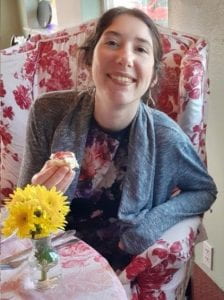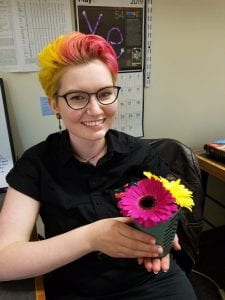 Loading...
Loading...
OIM Rotation Talks – March 30th, April 1st & 2nd
 Loading...
Loading...
 Loading...
Loading...

UO Chemistry and Biochemistry graduate student Hazel Fargher has been named the department’s 2020-21 John Keana Fellow, and has also recently been selected for the Department of Energy’s Office of Science Graduate Student Research (SCGSR) Program. Hazel is in her fifth year of the UO Chemistry Doctoral program, working on a joint project between the D.W. Johnson, Haley, and Pluth Labs.
The Keana Fellowship was established in 2017 in honor of Professor Emeritus John Keana, and provides annual fellowship awards to graduate students studying in the Department of Chemistry and Biochemistry at the University of Oregon. The award may be used to assist with defraying the academic costs associated with attending the university such as tuition, fees, books, miscellaneous supplies, research and living expenses.
The SCGSR Program is open to graduate students pursuing doctoral degrees in areas of physics, chemistry, material sciences, biology (non-medical), mathematics, engineering, computer or computational sciences, or specific areas of environmental sciences that are aligned with the mission of the Office of Science. The award provides supplemental funds for recipients to conduct part of their thesis research at a host DOE laboratory in collaboration with a DOE laboratory scientist. The research projects are expected to advance the graduate awardees’ overall doctoral research and training while providing access to the expertise, resources, and capabilities available at the DOE laboratories. Hazel is one of 52 students nation-wide that were selected for the award this fall.
I grew up on Cape Cod, Massachusetts, not too far from the beach. I went to Worcester Polytechnic Institute (WPI) in MA for my undergraduate degree in chemistry. I then started my first year of graduate school at UO in 2016.
I first got really excited about research when I learned about the principles of ‘green chemistry’. This is a really vague term but can refer to any chemical research that helps address environmental problems. During my time at WPI, I worked in Prof. Marion Emmert’s lab, studying ways to separate mixtures of rare earth elements so that they can be recycled. Now, I hope that some of the really fundamental work that I’m doing in physical organic chemistry can one day be useful in applications such as chemical sensing and pollutant extraction.
I am a host-guest chemist, so I design and synthesize organic hosts to bind guest molecules. More specifically, I develop hosts to bind hydrosulfide, which is both a highly toxic, foul-smelling molecule usually found in wastewater, and also a biomolecule that is essential for life.
I’m very excited to share that this award will help fund an internship at Oak Ridge National Lab through the DOE Office of Science Graduate Student Research program. I will be bringing hosts designed in the DWJ and Haley labs to the Moyer chemical separations group. We hope to use these hosts to study ion pair extraction of radioactive cesium salts from water. This area of research can be used to remove cesium nuclear waste from waterways and tank storage.
After getting my PhD, I would love to continue to do hands-on research in a lab. I am keeping an eye out for post-doc positions and opportunities at national labs.
Chemistry graduate student Checkers Marshall has been selected as the next recipient of the Rosaria Haugland Graduate Research Fellowship.
The Haugland Fellowship is a prestigious award. It is the first graduate research fellowship ever awarded by the UO Chemistry and Biochemistry Department and made possible by a generous gift from Dr. Rosaria Haugland. Dr. Haugland is the co-founder of Molecular Probes, which was a Eugene company founded in 1975 that is now part of Thermo Fisher’s Invitrogen brand. Checkers was selected from a highly accomplished pool of applicants for excellence in research on metal organic framework nanoparticles, coursework, and ongoing activities that embody the intent of the Haugland award.

I grew up in Denver, a city with a vibrant artistic community. In my high school years, I performed slam poetry at open mics and fell in love with the art of fire spinning. My interests in chemistry and art share a common theme: symmetry. I am designing a series of interactive workshops, Point Groups for Props, to teach performance artists how to apply group theory to their props: hula hoops, juggling clubs, and more can be easily categorized by their symmetry operations. My main props are Russian fire fans, which have a point group of C2V.
I received my BS in Chemistry from Fort Lewis College, a small liberal arts institution in the San Juan mountains in Colorado. I excelled in my first semester of chemistry under Dr. Aimee Morris, who asked me to TA general chemistry lab the following term. This simple act catalyzed my academic career; I am forever grateful to Dr. Morris and the other incredible professors I had at FLC who encouraged my progress and pushed me to become a better scientist. I enjoyed a relatively diverse community at FLC. Many of my professors were women, and because the college gives free tuition to Indigenous students, many of the folks I talked science with were of Indigenous descent. Today I aim to use my position to elevate the voices of the underrepresented and to create a welcoming environment in the traditionally exclusive world of academic science.
I joined Dr. Carl Brozek’s research lab as his first student during the summer of 2018. My research focuses on nanoparticles of highly porous materials known as metal-organic frameworks (MOFs). Understanding how MOF nanoparticles grow allows us to design rational syntheses that target specific particle sizes and functionalities. One of the most promising applications of MOF particles is in gas separation membranes, which must be very thin to be applicable in industrial settings. Controlling particle size is therefore an important step in this direction. I am particularly interested in MOFs that are capable of charge transport; conductive, porous, well-ordered materials are attractive for energy-dense charge storage devices. I am currently developing a model system to study ionic and electronic charge transport in assemblies of porous MOF particles. I believe this fundamental work will pave the way towards the integration of MOFs in electronic devices.
I am keeping my options open, but I aim to join a small company or start-up in sustainable technology that would benefit from my skill set. Regardless of what I choose to do in my scientific career, I hope to return to the Rocky Mountains, get a cat, and continue my journey in the performing arts.
 Loading...
Loading...
 Loading...
Loading...
 The 10th annual Undergraduate Research Symposium will take place this Thursday, May 21, 2020. The virtual format will include research work conducted by 18 chermistry and biochemsitry majors.
The 10th annual Undergraduate Research Symposium will take place this Thursday, May 21, 2020. The virtual format will include research work conducted by 18 chermistry and biochemsitry majors.
The presentations will be a mix of live-stream, pre-recprded and Zoom events. Zoom events require an RSVP by Wednesday, May 20 at noon. See the virtual Symposium navigation guide for details.
Stacey Andreeva – Chemistry
Faculty Mentor(s): Carl Brozek
Session 5: The Bonds that Make Us
Title: Metal-Ligand Bond Dynamics in Metal-Organic Frameworks Confirmed by Variable
Temperature Vibrational Spectroscopy
Dylan Bardgett – Chemistry
Faculty Mentor(s): Dave Johnson | Danielle Hamann
Session 6: Interact & React
Title: The Reactions Between Iron and Selenium
Zack Basham – Biochemistry
Faculty Mentor(s): David Garcia
Session: Pre-recorded Poster Presentation
Title: Influence of a prion protein on the TOR pathway in Saccharomyces Cerevisiae
Lejla Biberic – Biochemistry
Faculty Mentor(s): Amber Rolland | James Prell
Session: Pre-recorded Poster Presentation
Title: Determining detergent dependence of Cytolysin A oligomeric state through native mass
spectrometry
Anabel Chang – Biochemistry
Co-Presenter(s): Maya Pande
Session: Pre-recorded Poster Presentation
Faculty Mentor(s): Andrew Marcus
Title: Characterizing the Conformational Fluctuations of DNA Under Physiological and SaltStabilized Conditions
Emmalyn Leonard – Biochemistry
Faculty Mentor(s): Cristopher Niell | Philip Parker
Session 5: The Wonders of the Brain
Title: Determining the role of the pulvinar in visual attentional control
Tristan McKibben – Biochemistry
Faculty Mentor(s): J. Josh Snodgrass
Session 5.5: McNair Scholars Presentations
Title: The Evolution of Coronaviruses: Cross-Species Transfers and Mechanisms of Infections
Parker Morris – Chemistry
Faculty Mentor(s): Amanda Cook | Kiana Kawamura
Session: Pre-recorded Poster Presentation
Title: Rational Design and Synthesis for Nickel Catalyzed Hydrosilylation
Matthew Nardoci – Biochemistry/Biology
Co-Presenter(s): Jewlyssa Pedregon
Faculty Mentor(s): Santiago Jaramillo
Session: Pre-recorded Poster Presentation
Title: Characterization of sound-evoked responses of photo-identified auditory striatal neurons
Jake Olsen – Chemistry and Mathematics
Faculty Mentor(s): Marina Guenza | Jake Searcy
Session 1: It’s a Science Thing
Title: The Atomistic Reconstruction of Coarse-Grained Polymeric Systems via Machine Learning
Techniques
Maya Pande – Biochemistry, Political Science
Co-Presenter(s): Anabel Chang
Faculty Mentor(s): Andrew Marcus
Session: Pre-recorded Poster Presentation
Title: Characterizing the Conformational Fluctuations of DNA Under Physiological and SaltStabilized Conditions
Madelyn Scott – Chemistry, Physics
Faculty Mentor(s): Kelly Wilson | Cathy Wong
Session 2: Cells R Us
Title: Quantifying the spatial morphology of organic films through polarization-dependent
imaging
Nathan Stovall – Chemistry
Faculty Mentor(s): Shannon Boettcher | Raina Krivina
Session 5: The Bonds that Make Us
Title: Ultrathin Iridium Oxide Catalyst on a Conductive Support for the Oxygen Evolution
Reaction in Acid
Eric Strand – Biology/Biochemistry
Faculty Mentor(s): Joshua Barker
Session: Pre-recorded Poster Presentation
Title: Rational Design of s-Indacene-cored Small Molecule Organic Semiconductors as a
Paradigm to Tune Electronic Characteristics
Ian Torrence – Biochemistry
Faculty Mentor(s): Sean Fontenot
Session 2: Cells R Us
Title: Sensors and Materials for In-field Aqueous Analysis of Nitrate and Other Ions
Dan Tudorica – Biochemistry
Faculty Mentor(s): Arden Perkins
Session 3: The Substance of Us
Title: The role of the Chemoreceptor Zinc-Binding Domain in bacterial signal transduction
Nicole Wales – Chemistry and Physics
Faculty Mentor(s): Mark Lonergan | Zack Crawford
Session 5: The Bonds that Make Us
Title: Quantification of Point Defects in Perovskite Solar Cells
Daria Wonderlick – Biochemistry
Faculty Mentor(s): Mike Harms
Session 5: The Bonds that Make Us
Title: Ensembles link RNA thermodynamics and molecular evolution
